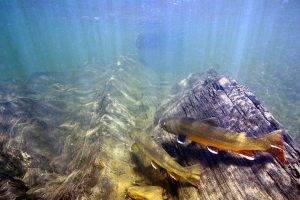
There are no zebra mussel or whirling disease infections in Jasper National Park but if the wrongheaded practice of self-stocking continues in Western Canada, it may only be a matter of time.
ÔÇťYouÔÇÖre killing your own enjoyment,ÔÇŁ Parks aquatic technician Traudi Golla told a small gathering of biology keeners at the Jasper Municipal Library on July 26.
The last mass stocking in the park was in 1988 and since then the transport of fish from one body of water to another has been forbidden.
Illegal stocking is what Parks believes brought whirling disease to Banff National Park, Golla said, but failing to properly clean, drain and dry watercraft is just as much of a threat.
ÔÇťIf there is one message you take away from here, it is clean, drain and dry,ÔÇŁ she said.
Also important - felt-soled boots, used by anglers to get traction on slimy riverbeds, are forbidden, since they are difficult to decontaminate and provide a perfect environment to transport invasive spores.
According to Parks CanadaÔÇÖs website Jasper is the only mountain national park that isnÔÇÖt under a catch and release order for all fish with the exception of lake trout caught in the Lake Minnewanka Reservoir, in Banff National Park.
Whirling disease ravages the developing ligaments around the brain of a fry, or fish toddler, but is not fatal for an older fish with fully developed bones in its skull.
ÔÇťWe donÔÇÖt want whirling disease but it was found in Banff so itÔÇÖs a focus for Parks,ÔÇŁ said Golla.
Invasive zebra mussels can be kept out of the park with the same precautions. Golla said the spores that lead to infestations of the tiny water cleaning machines can survive several times longer than those of whirling disease.
Intensely effective filters, zebra mussels alter the biology of a water body by removing particles from the water column and improving clarity. In Lake Erie, for example, the clearer water has allowed submerged vegetation to grow out, decay and wash up on shorelines, fouling beaches. The one-inch mussels, which arrived from Eastern Europe in the bilge tanks of merchant ships in the 1980s, are also known to clog water infrastructure.
The nearest infestation to Jasper is 10 miles south of the Alberta-U.S. border.
Golla was most passionate when she spoke about the dangers of invasive species but she also gave a comprehensive overview of the state of various fish species in the park, including pike, bull, rainbow, brook and lake trout and the healthiest mountain whitefish population in the province.
The whitefish was a target of the poisoning campaigns of decades past since their small mouths made for more difficult angling. Golla said every one of the 32 lakes around Jasper was poisoned at some point.
Humans also fouled up when they installed culverts that either cut fish off from travelling to an area they traditionally inhabited or made it very difficult for them to pass.
ÔÇťBut thanks to modern day stocking, there are fish all over the park now.ÔÇŁ
A brochure of current fishing regulations for the mountain national parks is available on the Parks Canada website.
Craig Gilbert
[email protected]
